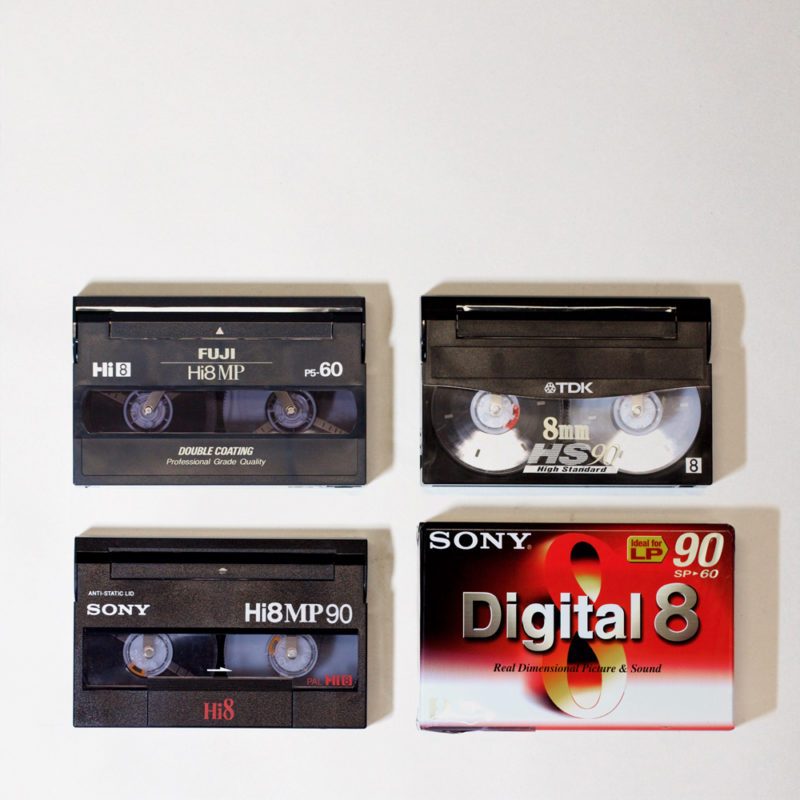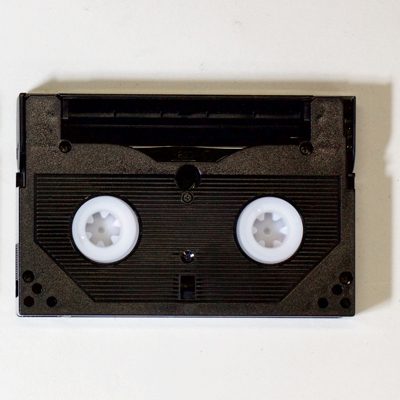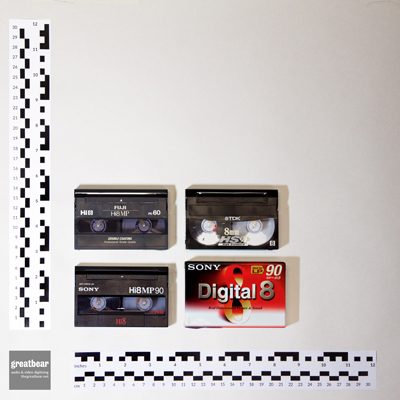introduction to 8mm video cassette transfer
Video8, Hi8 and Digital8 are three related 8mm video cassette formats. Video8 (introduced in 1985), and the improved Hi8 (1989) tapes were popular among home videographers and small-budget, independent film-makers. They were succeeded in 1999 by Digital8, a combination of the older Hi8 tape transport with a DV (Digital Video) codec.
At Greatbear we have the machines and expertise to convert all 8mm video formats to high-quality digital files.
We offer a range of delivery formats for our video transfers. Following International Association of Sound and Audiovisual Archives TC-06 guidelines, we deliver FFV1 lossless files or 10-bit uncompressed video files in .mkv or .mov containers for archives. We can also produce Apple ProRes mezzanine files for ease of editing. We provide smaller viewing files as H.264 encoded .mp4 files or on DVD. We're happy to create any other digital video files, according to your needs.
We can provide the appropriately-sized USB delivery media for your files, or use media supplied by you, or deliver your files online. Files delivered on hard drive can be for any operating system MacOS, Windows or GNU/Linux and filesystems (HFS+, NTFS or EXT3).
8mm video cassette recordings can vary both in duration and in the extent of physical tape degradation, so we always assess tapes before confirming the price of a transfer.
We offer free assessments - please contact us to discuss your project.
For an introduction to our assessment and treatment processes, please see our guide to "what happens to your video tape".
8mm video machines
8mm / Hi8
- Sony EV PR-2 (NTSC)
- Sony EV-S700 (PAL)
- Sony EVO-9800 (PAL) x 2
- Sony EVO-9850 (PAL)
- Sony EVO-9850 (NTSC)
Digital8
- Sony TRV
8mm video format variation
| video standard | 8mm recording type | preservation analogue digitising supported | digital transfer supported | AFM audio soundtrack supported | PCM digital audio soundtrack supported | PCM multi audio: 6 digital tracks per tape supported |
|---|---|---|---|---|---|---|
| PAL | Video8 | ✓ | n/a | ✓ | ✓ | ✓ |
| PAL | Hi8 | ✓ | n/a | ✓ | ✓ | ✗ |
| PAL | Digital8 | ✓ | ✓ | n/a | ✓ | n/a |
| NTSC | Video8 | ✓ | n/a | ✓ | ✓ | ✗ |
| NTSC | Hi8 | ✓ | n/a | ✓ | ✓ | ✗ |
| NTSC | Digital8 | ✓ | ✓ | n/a | ✓ | n/a |
Scroll to the right to view full table on smaller screens.
Video8 / Hi8 / Digital8 tape risks & vulnerabilities
Video8, Hi8 and Digital8 are all relatively threatened video formats due to machine obsolescence and the fragility of the tape.
8mm video recording didn't have the market penetration that VHS tape had, in part due to its smaller size and resultant lower recording durations and the lack of pre-recorded material available. Consequently, most of the VTRs produced and sold for the 8mm format were portable cameras. Full-sized VTR decks for domestic or editing use do exist, but in much smaller numbers.
8mm video tape is very thin compared to older analogue video tape, and as a result is fragile to physical damage and from issues with mould. When contaminated with mould it is very vulnerable to splitting longitudinally. We regularly see Video8, Hi8 and Digital8 tapes that have been left in damp environments with mould growth on the edge of the tape pack. Unless dealt with carefully, it will always result in damaged tapes and playback error if play is attempted in their mouldy state.
Audio tracks can also be problematic with 8mm video, as there is no separate, longitudinal analogue audio track. The AFM and PCM audio tracks are recorded with the video, so any issues with the tape path alignment or head tip wear will cause partial loss or full loss of audio. Other analogue formats such as VHS, U-matic, Betamax and Betacam all had longitudinal analogue audio tracks that would still be accessible and audible independently from the video signal.
Common brands / models of Hi8 tape include: Sony ProME / E5-90HMEX.
8mm video history
Video8 was developed by Eastman Kodak in 1984 and boosted by the launch of Sony's Handycam in 1985. It was an entirely analogue format, and became very popular in the consumer camcorder market.
Hi8 was introduced by Sony in 1989, and comprised analogue video and audio, with provision for digital audio. Hi8 was short for "High-band Video8" and used improved recorder electronics and media formulation to increase the bandwidth of the luminance signal to 2.0 MHz (from 1.2 MHz bandwidth for Video8).
Hi8 was succeeded in 1999 by Digital8, a combination of the older Hi8 tape transport, but with a DV (Digital Video) codec.
Video8/Hi8 was popular enough with small-budget and amateur videographers for Sony to produce equipment for video editing and production. At Greatbear we often see 8mm video formats having been used by artists and independent film makers - see tape blog post: The Great Hip Hop Hoax
Video cassettes and tape boxes for Video8, Hi8 and Digital8 can be identified by these logos. All three are trademarks of the Sony Corporation.






